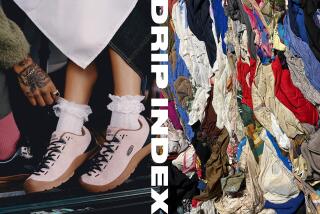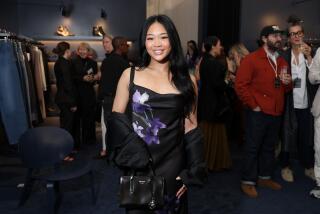Athletic Chic Is Shoe-In at Footwear Show
- Share via
The subject was shoes: men’s shoes, women’s shoes, children’s shoes, dressy shoes, preppy shoes, running shoes, walking shoes. And, oh yes, boots. Mink-lined boots.
In all, 1,800 brands were on display at the Western Shoe Associates fall international buying market. Back in Los Angeles for the first time in 15 years, the three-day show occupied every available inch (390,000 square feet in all) of the Los Angeles Convention Center.
There might have been footwear everywhere, but the outstanding performers weren’t hard to find. They were the athletic shoes, especially those in the L.A. Gear booth, which seemed busier and showier than any other.
Large Display Area
“I’ve been accused of catering to the bubble-gum crowd,” president Robert Greenberg said happily as he glanced around his large display area, noticeably enhanced by the three L.A. Gear dancers who were resting between performances.
The teeny-bopper connotation is exactly what Greenberg is after: “I think junior. Our product is young, fresh, exciting. If 16- to 18-year-olds won’t wear it, I won’t make it. It’s Disneyland, Technicolor. It’s our way of spreading the joy.”
The joy is found all over the United States and in Japan, Canada, Switzerland and Germany. Sales figures for 1985 were $10 million; they climbed to $36 million in 1986. That figure will double this year, Greenberg assures anyone who asks about business projections.
Four-year-old L.A. Gear (“You make the moves, we make the shoes”) tries out its ideas on groups of 16-year-olds in various high schools. Greenberg does the designing, and, according to him, the hottest shoe at the moment is a woman’s white leather basketball style with colorful trim that retails for $40 to $52.
There are also basketball shoes for guys, decal-splashed high-top sneakers in either denim- or khaki-look canvas and children’s versions of the teen-oriented styles.
One of Greenberg’s favorite new designs is a white leather aerobic shoe, decorated with cutouts of palm tress, the sun and a little bit of ocean.
“No one has done that,” he said with a broad smile.
Not far away, Reebok sales representatives were gazing with pride at their new product: Weebok.
The name had a way of eliciting baby talk from some people. “We’re the Weebok weps,” joked one rep. But not Mike Moloney. He was all business as he discussed the company’s line of special shoes for tots. (Slogan: “There’s a little Reebok in every shoe.”)
“It’s a whole new direction for us,” Moloney explained. “The shoes aren’t even going to the same accounts. No athletic stores.”
Instead, “the casual, serviceable” shoes for children, with firm heel counters and flexible toes, will be found in stores such as Nordstrom. Priced $26 to $28, the miniature athletic models are available with laces or Velcro closures in pastels, primary colors and, of course, Weebok white.
At the playhouse-cute booth run by Toddler University, the selling point was athletic-looking shoes in “laundry leather” for the crawling, toddling, walking set.
Company president Jeff Silverman, a former Nike employee, explained the Korean leather is softened by tumbling it in talcum powder, then it is cut and sewn, not glued, he emphasized.
Just to be sure consumers know all the details, each pair comes with a tiny hangtag shaped like a school notebook. And Silverman is confident his customers read the information. After all, they’re grown-up baby boomers, he said, producing the next round of baby boomers: “They have education and style.”
Over at the Vision booth, the customer was described as 9 to 25 and hooked on skateboarding, or at least the image. The Costa Mesa-based company, which has been manufacturing skateboards for 10 years, has branched out into a new line of clothing and “fashion” board shoes, including two-tone suede models that retail for about $37.
Shoes and clothing are designed by skaters for skating, according to sales manager Greg Novander, who explained the goal was to have the goods withstand treatment so rugged he referred to it as “torture.”
Skateboarding, on its feet again after dwindling in the late ‘70s, “is a sport more than a fad now,” Novander noted. “It’s more acceptable.”
Vision, he said, was never one to promote the stereotypical tough side. The company always kept the art on its boards aboveboard, as it were.
“We don’t do gory, death-type images,” he added. “We try to keep it clean. We don’t do the kind of skateboard that a kid has to hide under his bed at home.”
The top trend in dressier styles for women turned out to be flats, many of them with thick, rubbery platform soles.
For men, the lugged-sole look is part of the fall lineup, obviously there to be paired with casual attire. On the more elegant side are the extravagant reptile offerings from Mauri U.S.A.
Exotic Skins
While the company’s Italian-made boots and shoes for women retail for $225 to $1,000, the men’s line starts at $300 and ends at more than $1,000. According to company executive Jerome Deutel: “Our customer is someone looking for the No.1 exotic-skin shoes in the world.” Bank account rather than age determines a Mauri man, he said, but that usually means the client is 35 and older.
Bankers and insurance executives tend to buy a “conservative,” tasseled alligator slip-on for $500, while men with fancier tastes like to slip into a $1,500 alligator demi-boot.
“Lined almost to the toes,” Deutel explained, “in mink.”
More to Read
Inside the business of entertainment
The Wide Shot brings you news, analysis and insights on everything from streaming wars to production — and what it all means for the future.
You may occasionally receive promotional content from the Los Angeles Times.










